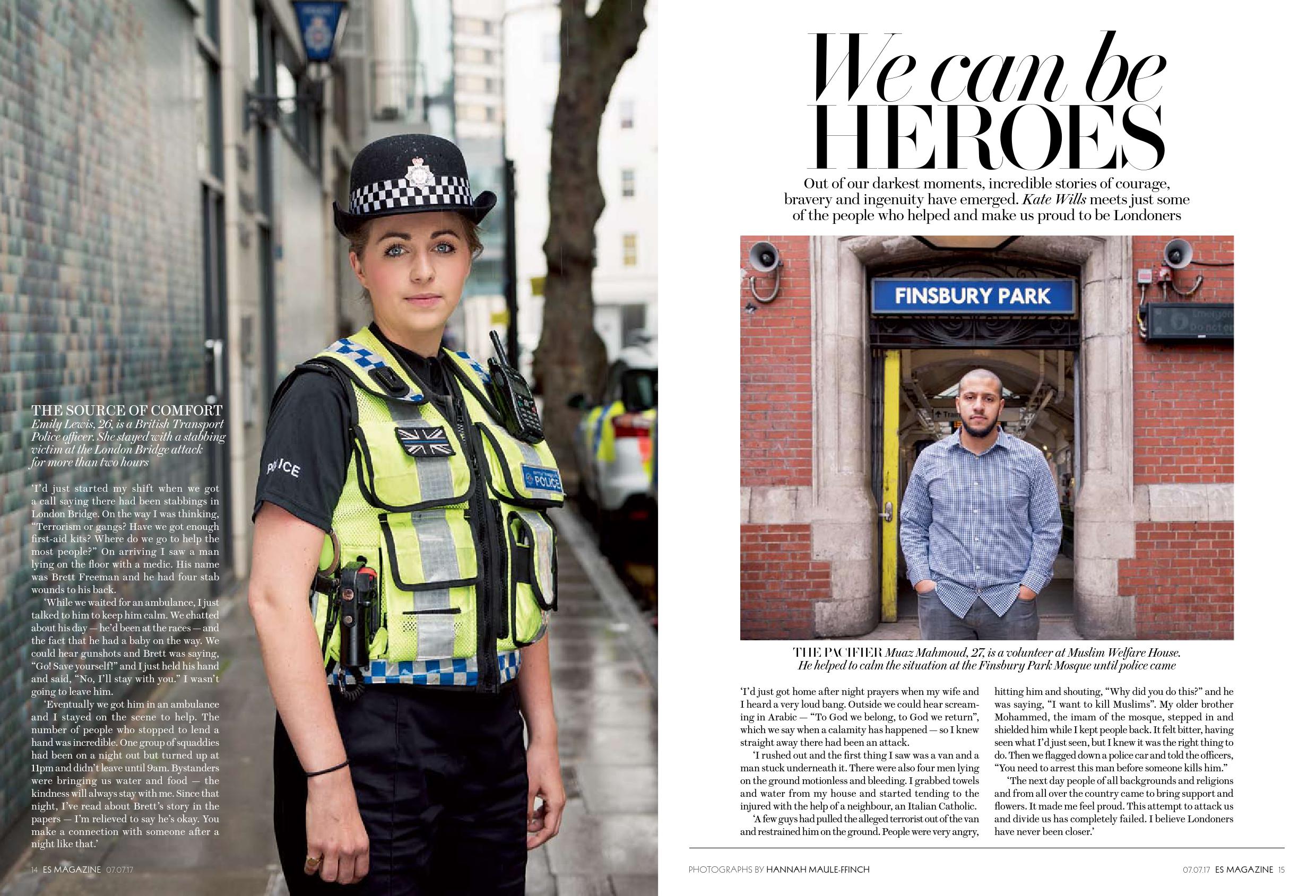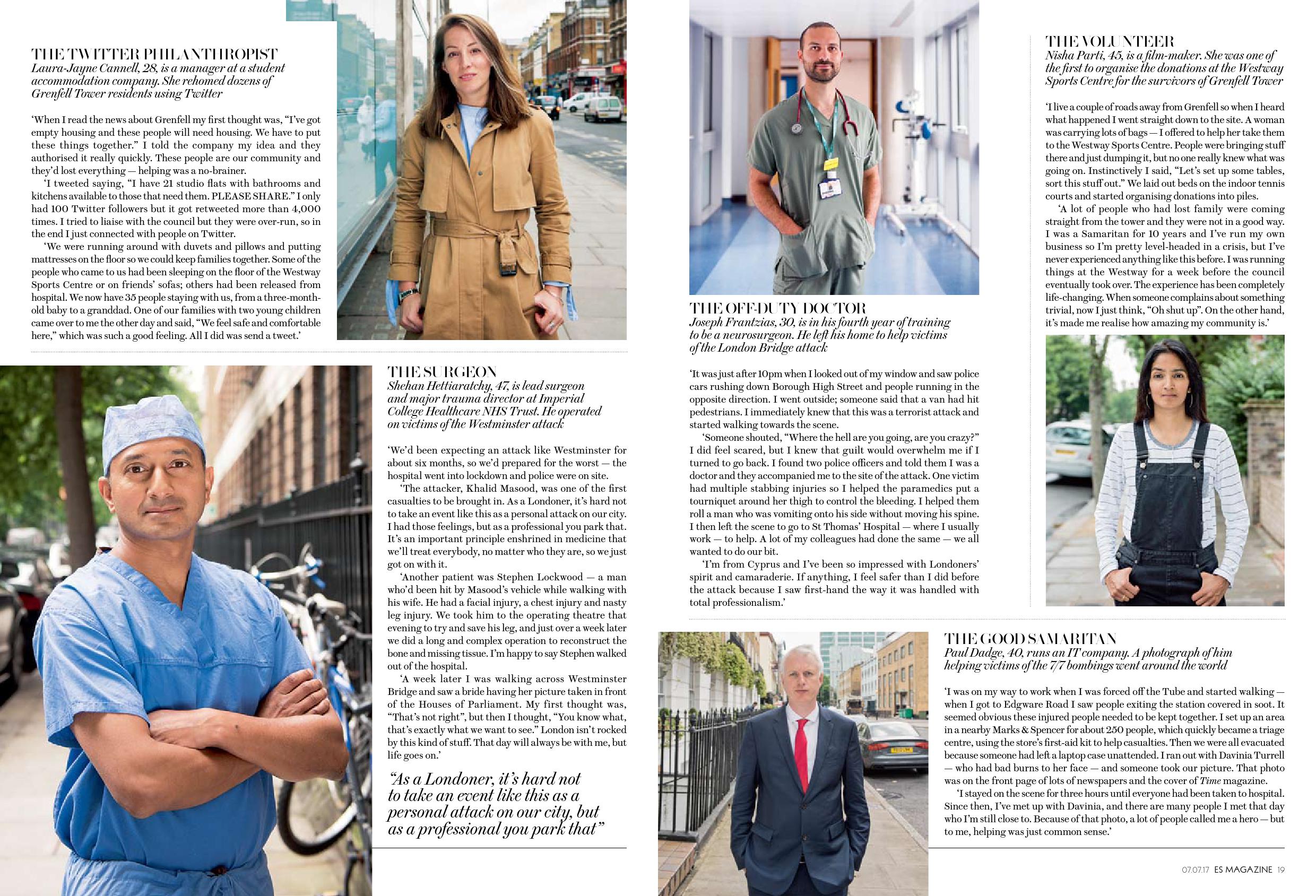
 Out of our darkest moments, incredible stories of courage, bravery and ingenuity have emerged.
Out of our darkest moments, incredible stories of courage, bravery and ingenuity have emerged.
Here just some of the people who helped, from a British Transport Police officer to a surgeon, via a Twitter philanthropist.
THE SOURCE OF COMFORT
Emily Lewis, 26, is a British Transport Police officer. She stayed with a stabbing victim at the London Bridge attack for more than two hours
‘I’d just started my shift when we got a call saying there had been stabbings in London Bridge. On the way I was thinking, “Terrorism or gangs? Have we got enough first-aid kits? Where do we go to help the most people?” On arriving I saw a man lying on the floor with a medic. His name was Brett Freeman and he had four stab wounds to his back.‘While we waited for an ambulance, I just talked to him to keep him calm. We chatted about his day – he’d been at the races – and the fact that he had a baby on the way.
We could hear gunshots and Brett was saying, “Go! Save yourself!” and I just held his hand and said, “No, I’ll stay with you.” I wasn’t going to leave him. ‘Eventually we got him in an ambulance and I stayed on the scene to help. The number of people who stopped to lend a hand was incredible. One group of squaddies had been on a night out but turned up at 11pm and didn’t leave until 9am. Bystanders were bringing us water and food – the kindness will always stay with me. Since that night, I’ve read about Brett’s story in the papers – I’m relieved to say he’s okay. You make a connection with someone after a night like that.’
THE PACIFIER
Muaz Mahmoud, 27, is a volunteer at Muslim Welfare House. He helped to calm the situation at the Finsbury Park Mosque until police came
‘I’d just got home after night prayers when my wife and I heard a very loud bang. Outside we could hear screaming in Arabic – “To God we belong, to God we return”, which we say when a calamity has happened – so I knew straight away there had been an attack. ‘I rushed out and the first thing I saw was a van and a man stuck underneath it. There were also four men lying on the ground motionless and bleeding. I grabbed towels and water from my house and started tending to the injured with the help of a neighbour, an Italian Catholic. ‘A few guys had pulled the alleged terrorist out of the van and restrained him on the ground. People were very angry, hitting him and shouting, “Why did you do this?” and he was saying, “I want to kill Muslims”. My older brother Mohammed, the imam of the mosque, stepped in and shielded him while I kept people back. It felt bitter, having seen what I’d just seen, but I knew it was the right thing to do. Then we flagged down a police car and told the officers, “You need to arrest this man before someone kills him.”
‘The next day people of all backgrounds and religions and from all over the country came to bring support and flowers. It made me feel proud. This attempt to attack us and divide us has completely failed. I believe Londoners have never been closer.’
THE TWITTER PHILANTHROPISTÂ
Laura-Jayne Cannell, 28, is a manager at a student accommodation company. She rehomed dozens of Grenfell Tower residents using Twitter
‘When I read the news about Grenfell my first thought was, “I’ve got empty housing and these people will need housing. We have to put these things together.” I told the company my idea and they authorised it really quickly. These people are our community and they’d lost everything – helping was a no-brainer. ‘I tweeted saying, “I have 21 studio flats with bathrooms and kitchens available to those that need them. PLEASE SHARE.” I only had 100 Twitter followers but it got retweeted more than 4,000 times.
I tried to liaise with the council but they were over-run, so in the end I just connected with people on Twitter. ‘We were running around with duvets and pillows and putting mattresses on the floor so we could keep families together. Some of the people who came to us had been sleeping on the floor of the Westway Sports Centre or on friends’ sofas; others had been released from hospital. We now have 35 people staying with us, from a three-month-old baby to a granddad. One of our families with two young children came over to me the other day and said, “We feel safe and comfortable here,” which was such a good feeling. All I did was send a tweet.’
THE SURGEONÂ
Shehan Hettiaratchy, 47, is lead surgeon and major trauma director at Imperial College Healthcare NHS Trust. He operated on victims of the Westminster attack
‘We’d been expecting an attack like Westminster for about six months, so we’d prepared for the worst – the hospital went into lockdown and police were on site.
‘The attacker, Khalid Masood, was one of the first casualties to be brought in. As a Londoner, it’s hard not to take an event like this as a personal attack on our city. I had those feelings, but as a professional you park that. It’s an important principle enshrined in medicine that we’ll treat everybody, no matter who they are, so we just got on with it.
‘Another patient was Stephen Lockwood – a man who’d been hit by Masood’s vehicle while walking with his wife. He had a facial injury, a chest injury and nasty leg injury. We took him to the operating theatre that evening to try and save his leg, and just over a week later we did a long and complex operation to reconstruct the bone and missing tissue. I’m happy to say Stephen walked out of the hospital.
‘A week later I was walking across Westminster Bridge and saw a bride having her picture taken in front of the Houses of Parliament. My first thought was, “That’s not right”, but then I thought, “You know what, that’s exactly what we want to see.” London isn’t rocked by this kind of stuff. That day will always be with me, but life goes on.’
THE VOLUNTEER
Nisha Parti, 45, is a film-maker. She was one of the first to organise the donations at the Westway Sports Centre for the survivors of Grenfell Tower
‘I live a couple of roads away from Grenfell so when I heard what happened I went straight down to the site. A woman was carrying lots of bags – I offered to help her take them to the Westway Sports Centre. People were bringing stuff there and just dumping it, but no one really knew what was going on. Instinctively I said, “Let’s set up some tables, sort this stuff out.” We laid out beds on the indoor tennis courts and started organising donations into piles.
‘A lot of people who had lost family were coming straight from the tower and they were not in a good way. I was a Samaritan for 10 years and I’ve run my own business so I’m pretty level-headed in a crisis, but I’ve never experienced anything like this before. I was running things at the Westway for a few days before the council eventually took over. The experience has been completely life-changing. When someone complains about something trivial, now I just think, “Oh shut up”. On the other hand, it’s made me realise how amazing my community is.’
THE GOOD SAMARITAN
Paul Dadge, 40, runs an IT company. A photograph of him helping victims of the 7/7 bombings went around the world
‘I was on my way to work when I was forced off the Tube and started walking – when I got to Edgware Road I saw people exiting the station covered in soot. It seemed obvious these injured people needed to be kept together. I set up an area in a nearby Marks & Spencer for about 250 people, which quickly became a triage centre, using the store’s first-aid kit to help casualties. Then we were all evacuated because someone had left a laptop case unattended. I ran out with Davinia Turrell – who had bad burns to her face – and someone took our picture. That photo was on the front page of lots of newspapers and the cover of Time magazine.
‘I stayed on the scene for three hours until everyone had been taken to hospital. Since then, I’ve met up with Davinia, and there are many people I met that day who I’m still close to. Because of that photo, a lot of people called me a hero – but to me, helping was just common sense.’
THE OFF-DUTY DOCTOR
Joseph Frantzias, 30, is in his fourth year of training to be a neurosurgeon. He left his home to help victims of the London Bridge attack
‘It was just after 10pm when I looked out of my window and saw police cars rushing down Borough High Street and people running in the opposite direction. I went outside; someone said that a van had hit pedestrians. I immediately knew that this was a terrorist attack and started walking towards the scene.
‘I’m from Cyprus and I’ve been so impressed with Londoners’ spirit and camaraderie. If anything, I feel safer than I did before the attack because I saw first-hand the way it was handled with total professionalism.’






